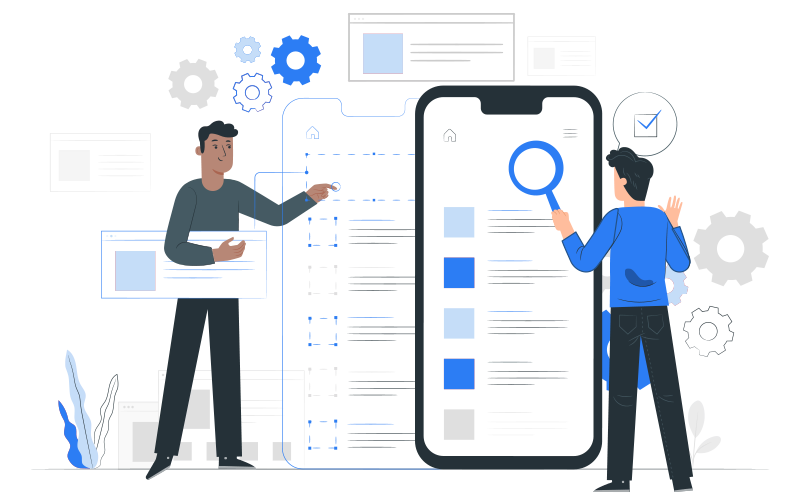10 Key Steps to Successful Mobile App Testing

Rathinakumar // 16-11-2023
10 Key Steps to Successful Mobile App Testing
Mobile app testing is essential for delivering a seamless and reliable user experience.In the competitive field of app development, it is crucial to test your mobile app thoroughly. A well-executed testing process not only detects bugs and glitches but also enhances user satisfaction, establishes credibility, and contributes to the overall success of your app. In this blog post, we’ll explore the essential steps to guide you for a successful mobile app testing journey.
Step 1: Define Clear Testing Objectives
Before diving into the testing process, it’s crucial to define clear testing objectives. Ask yourself: What are you trying to achieve through testing? Setting specific goals helps in crafting a focused testing strategy. Whether it’s ensuring functionality across different devices or validating the app’s performance under various conditions, having well-defined objectives guides the entire testing process. Objectives also serve as benchmarks for success, allowing you to measure the effectiveness of your testing efforts.
- Device Compatibility: Test across diverse devices to ensure seamless functionality.
- Performance Optimization: Evaluate app performance under varied scenarios for an optimal user experience.
- Security and Data Integrity: Establish robust security measures and validate data integrity to protect user information.
Step 2: Choose the Right Testing Environment
Selecting the appropriate testing environment is like setting the stage for a successful performance. Consider the diverse landscape of mobile devices, operating systems, and network conditions your users may encounter. Emulate these conditions in your testing environment to catch potential issues early. Investing time in creating a realistic testing environment pays off by identifying compatibility issues and ensuring a smooth user experience across different platforms
- Early Issue Identification: Emulate diverse conditions for early compatibility issue detection.
- Performance Across Platforms: Test in a realistic environment for optimal performance across various devices and systems.
- Robust Quality Assurance: Meticulous testing ensures comprehensive quality assurance for a polished and reliable end product.
Step 3: Establish a Comprehensive Test Plan
A detailed test plan is the roadmap that guides your testing journey. It outlines the scope, objectives, resources, schedule, and deliverables of the testing process. A well-structured plan ensures that testing activities are organized and resources are allocated efficiently. It acts as a reference point for all team members, providing clarity on their roles and responsibilities. A comprehensive test plan sets the foundation for a systematic and thorough testing approach.
- Resource Efficiency: A structured test plan ensures efficient resource allocation for maximum impact.
- Roles Clarity: The test plan serves as a reference, offering clear guidelines for team roles and fostering collaboration.
- Thorough Foundation: A comprehensive test plan establishes the groundwork for systematic and thorough testing, validating all software aspects.
Step 4: Select Appropriate Testing Types
Mobile app testing is not a one-size-fits-all endeavor. Different aspects of your app require different testing types. Functional testing ensures that all features work as intended, performance testing evaluates speed and responsiveness, security testing safeguards user data, and usability testing assesses the overall user experience. Tailor your testing strategy to include a mix of these testing types to cover all facts of your app’s functionality and user interaction.
- Functional Validation: Verify app features operate as intended through functional testing.
- Performance Assurance: Evaluate app speed and responsiveness for a smooth user experience in performance testing.
- Security Safeguard: Crucial security testing protects user data by identifying and mitigating potential vulnerabilities.
Step 5: Implement Effective Test Cases
The effectiveness of your testing lies in the strength of your test cases. Craft detailed and comprehensive test cases that cover a wide range of scenarios. Include positive test cases to validate expected behavior and negative test cases to identify potential pitfalls. Well-designed test cases serve as a guide for testers, ensuring that no stone is left unturned during the testing process. Thorough test cases are the building blocks of a successful testing effort.
- Positive Validation: Include positive test cases for expected behavior and ensuring intended software functionality.
- Negative Pitfalls: Craft negative cases to proactively uncover system pitfalls and weaknesses.
- Guiding Testers: Well-designed test cases guide testers, ensuring thorough scrutiny of every aspect during testing.
Step 6: Prioritize test cases
In the world of mobile app development and testing, time is often a limited resource. Prioritizing test cases based on critical functionalities and potential risks is a strategic approach. By focusing on high-priority test cases, you ensure that the most crucial aspects of your app are thoroughly tested, even in scenarios with tight timelines. Prioritization allows you to make the most of your testing efforts, concentrating on what matters most to your users.
- Strategic Prioritization: Identify critical functionalities and risks, concentrating efforts where they matter most for efficient testing.
- Time-Efficient Testing: Emphasize high-priority cases for thorough examination, even in tight timelines.
- User-Centric Focus: Prioritize testing to align with user priorities, enhancing overall user experience by addressing crucial functionalities first.
Step 7: Execute tests and gather data
With a well-defined plan and effective test cases in hand, it’s time to execute tests and gather data. Test execution involves running your test cases on the selected devices and platforms. Automated testing tools can streamline this process, ensuring consistency and efficiency. As tests run, gather relevant data, including performance metrics, error logs, and user feedback. This data serves as valuable insight into the app’s behavior under various conditions, guiding further improvements.
- Automated Efficiency: Testing tools streamline execution, ensuring efficient and systematic coverage.
- Data Insights: Collect performance metrics, error logs, and user feedback for a comprehensive understanding of app behavior.
- Guiding Improvements: The gathered data informs developers, guiding decisions for app enhancements.
Step 8: Perform Rigorous Regression Testing
As your app evolves with updates and new features, regression testing becomes imperative. This step ensures that new changes haven’t adversely affected existing functionalities. Regression testing involves re-running previously executed test cases to catch any unintended side effects. Implementing a robust regression testing process safeguards the stability and integrity of your app throughout its lifecycle.
- Evolution Preparedness: Regression testing is vital as your app evolves, preventing adverse impacts on existing functionalities.
- Consequence Mitigation: Re-running test cases catches unintended side effects, safeguarding your app’s stability.
- Lifecycle Assurance: Robust regression testing ensures the integrity and stability of your app throughout its lifecycle.
Step 9: Involve stakeholders in user acceptance testing.
User acceptance testing (UAT) is a crucial step that involves stakeholders, including end-users, in the testing process. Engaging users at this stage helps gather real-world feedback, ensuring your app meets their expectations. Stakeholders can identify usability issues, provide valuable insights, and contribute to the overall refinement of the app. UAT bridges the gap between app development and user expectations, creating a collaborative approach to app testing.
- Feedback Gathering: UAT involves end-users gathering authentic, real-world feedback on app functionality and user experience.
- Usability Issues: Stakeholders identify usability issues, leveraging unique perspectives to enhance the app’s interface and usability.
- Collaborative Refinement: UAT fosters collaboration, with stakeholders contributing valuable insights for real user-based refinement and improvement.
Step 10: Analyze Results and Iterate
The conclusion of the testing phase marks the beginning of result analysis and iteration. Examine the data collected during testing, identify issues, and prioritize necessary improvements. The iterative nature of mobile app development and testing allows for continuous refinement. Analyzing results and iterating on your app ensures that it evolves to meet user expectations and stays competitive in the dynamic mobile landscape.
- Precise Data Analysis: Examine collected data with precision, identifying issues to guide effective iteration.
- Priority Enhancement: Analyzing results prioritizes necessary improvements, addressing critical aspects promptly.
- Continuous Evolution: App development’s iterative nature integrates enhancements seamlessly for ongoing refinement and competitiveness.
Commencing the mobile app testing journey is pivotal for delivering a flawless user experience in the competitive realm of development. Thorough testing isn’t merely about bug detection; it’s a pathway to user satisfaction, app credibility, and overall success. These ten key steps, from defining clear objectives to iterative refinement, guide this process strategically. Execute efficient test cases, prioritize judiciously, and involve stakeholders for collaborative refinement. Embrace the continuous evolution facilitated by rigorous regression testing. Analyze the results meticulously to prioritize necessary improvements. Begin this transformative journey now, ensuring your app not only meets but exceeds user expectations. Happy testing!




